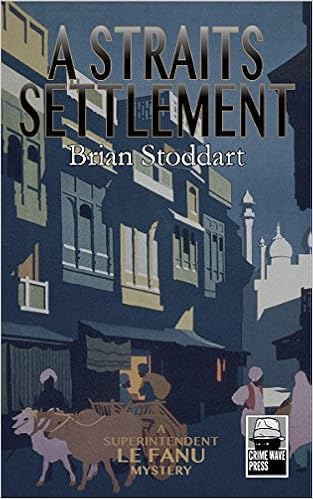500 words from...is a
series of guest posts from authors writing about Asia, or published by
Asia-based, or Asia-focused, publishing houses, in which they talk about their
latest books. Here Brian Stoddart, an Australian academic who worked in
Malaysia in the 1990s, talks about A
Straits Settlement the latest in his Superintendent Le Fanu series of crime
novels, set in the colonial-era of the 1920s, and published by Hong Kong based
Crime Wave Press.
A
Straits Settlement, the third book in the series, following A Madras Miasma and The Pallampur Predicament, both set in south India, sees Superintendent
Le Fanu promoted to Inspector-General of Police, and broadens his geographical
horizons across the Bay of Bengal into the British-controlled Straits
Settlements, where for the first time he encounters Chinese and Malay cultures.
As soon as he arrives he becomes entangled with Chinese secret societies and
the British colonial intelligence services. Not to mention the mysterious
Chinese woman who causes him to wonder about the British imperial future.
So, over to Brian…
I took Le Fanu out of
Madras for a couple of reasons.
The first was to
place him in the wider British Empire, its Asian one, at least. That allows me
to point to similarities and difference across the vast imperial holding. More
specifically, it shows continuity in the British approach to control, but a variation
in the local response. That is an important part of the tale about the rise and
decline of the Empire, and causes Le Fanu to think even more about his personal
and professional trajectories.
The second reason was
more personal. Along with my family, I loved living in Penang when I was
working there in the 1990s, and return visits reminded me just how wonderful a setting
it is for stories like this. That setting matches my fascination with so-called crime and place writing - where the location is as much a character as the
protagonists. Spending a month there a year or so ago allowed me to roam about
as a writer framing scenes, settings and possibilities, in a sense looking at
it as someone like Le Fanu would have done in the 1920s.
I hope Penangites
recognise some of A Straits Settlement
as authentic! Certainly, my friends will recognise the references to Straits
Chinese porcelain. My growing collection started when we lived there. Le Fanu is
drawn into the world of antiquities theft, and locals might even identify a
certain antiques shop in the book.
Importantly, though,
the change in locale from Madras to Penang allowed me to test Le Fanu, as it
were. By being there he sees possible different lifestyles and careers, an atmosphere
different from the one he has difficulty with in Madras. Much of that is
professional. In Penang he gets back to being a hands on detective, and that
underlines just how much frustration he has had being a mere manager back in
Madras. That is underlined by his colleagues in Penang - they are more like him
than those back in Madras where he is becoming regarded as even more of a
square peg in a round hole.
And then there is
Jenlin Koh, the Straits Chinese woman who brings yet more complexity to his
personal life.
Like the earlier
books, A Straits Settlement draws on
events and people of the time to give it historical authenticity. For example, I
have Le Fanu working in Penang with Rene Onraet who adds both a nice touch and
a neat link. Onraet was born in India where his father was in the Indian Civil
Service. Like the fictional Le Fanu, Onraet broke family tradition and joined
the Settlements police. He learned Hokkien and Malay, busted gambling rings and
criminal gangs, joined the intelligence service, became head of Special Branch
and later Inspector-General of Police before retiring to Hampshire where life
must have been very dull. This larger-than-but-real life character is the
perfect sounding board for Le Fanu.
By the end of the
book, then, Le Fanu is still in his new imperial setting and, as usual, facing
personal and professional choices. What will he do next? Le Fanu Four is on the
way.

